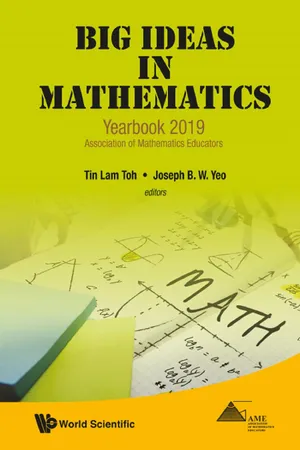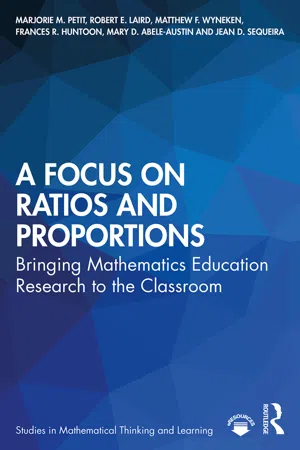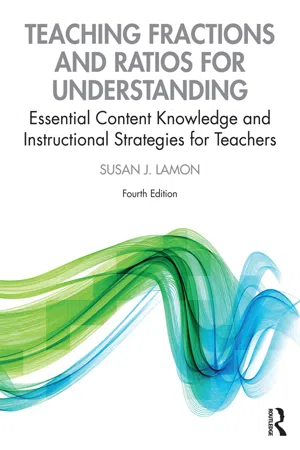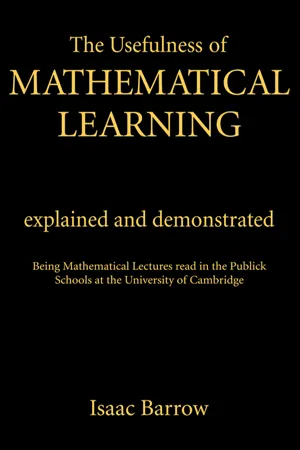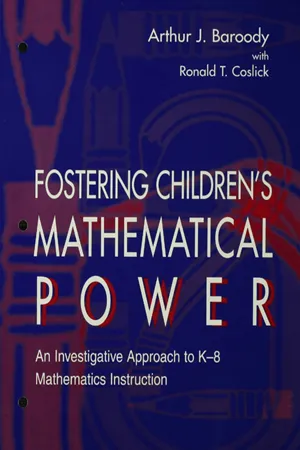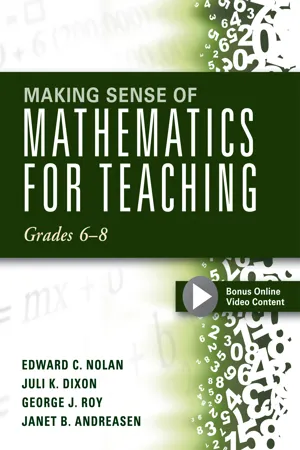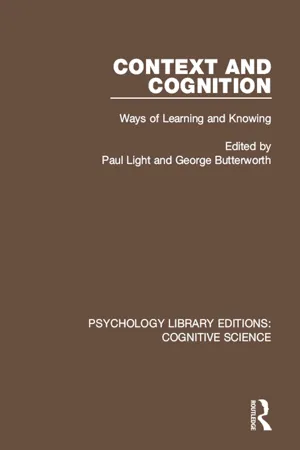Mathematics
Proportion
In mathematics, a proportion is a statement that two ratios are equal. It expresses the relationship between two sets of numbers or quantities. Proportions are often used to solve problems involving unknown quantities, and they play a key role in various mathematical concepts such as similarity and scaling.
Written by Perlego with AI-assistance
Related key terms
Related key terms
1 of 4
Related key terms
1 of 3
9 Key excerpts on "Proportion"
- eBook - ePub
Big Ideas in Mathematics
Yearbook 2019, Association of Mathematics Educators
- Tin Lam Toh, Joseph B W Yeo(Authors)
- 2019(Publication Date)
- WSPC(Publisher)
If the two or more ratio quantities encompass all of the quantities in a particular situation, it is said that “the whole” contains the sum of the parts: for example, a fruit basket containing two apples and three oranges and no other fruit is made up of two parts apples and three parts oranges. In this case, 2/5, or 40% of the whole is apples and 3/5, or 60% of the whole is oranges. This comparison of a specific quantity to “the whole” is called a Proportion.Ratio can be used to compare one part of a whole to another part of the whole, and this is called ‘part-to-part ratio’; on the other hand, ratio can also be used to compare one part of a whole to the whole itself, and this is called ‘part-to-whole ratio’ (Van de Walle et al., 2010). As explained above, both Cambridge Advanced Learner’s Dictionary & Thesaurus (2018) and Wikipedia (2018c) call the ‘part-to-whole ratio’ a Proportion. In the above example given in Wikipedia, it is common everyday usage to say that the Proportion of apples in the basket is 40%. In fact, in Section 3.3 , I have used the word ‘Proportion’ in the same manner when talking about the Proportion of boys in a class. Perhaps because of the usage of Proportion in this manner, anecdotal evidence shows that many students think that ratio and Proportion mean the same thing. However, there is another meaning of Proportion.4.2Concept of Proportionality and its relation to ratio
The Cambridge Academic Content Dictionary (2018a) also defines Proportion as follows: “[In mathematics] A Proportion is also an equation (= mathematical statement) that shows two ratios (= comparisons) are equal.” The overseas school textbook by Cathcart et al. (2006), mentioned earlier in Section 3.3 , puts it this way: “A Proportion is a statement that two ratios are equal.” (p. 273) In literature, Tourniaire and Pulos (1985) wrote, “For a mathematician, a Proportion is a statement of equality of two ratios, i.e. a/b = c/d.” But Wikipedia (2018a) uses the term ‘Proportionality’ to describe this concept: under the topic Proportionality (mathematics), it says, “In mathematics, two variables are Proportional if there is always a constant ratio between them. The constant is called the coefficient of Proportionality or Proportionality constant.” Then it proceeds to explain what direct and inverse Proportions are. In fact, as explained in Section 2 - eBook - ePub
A Focus on Ratios and Proportions
Bringing Mathematics Education Research to the Classroom
- Marjorie M. Petit, Robert E. Laird, Matthew F. Wyneken, Frances R. Huntoon, Mary D. Abele-Austin, Jean D. Sequeira(Authors)
- 2020(Publication Date)
- Routledge(Publisher)
The quantities are represented by points on the coordinate plane. Eleven distinct points are plotted on this graph, and each point on the line represents two quantities, one that specifies a number of tickets sold and one that indicates the corresponding amount of money earned. These two related quantities are in the same Proportional relationship as any other two related quantities that lie on this diagonal line.Another important visual feature of the line is that it passes through the origin, i.e., the point (0,0). Two features characterize a Proportional relationship on a coordinate plane:- a straight line
- and the straight line passes through the origin
Figure 2.9 In a coordinate plane, two quantities are represented by the plotted points on a lineIn the other representations we examined, each quantity was represented by its own number or visual element. In a ratio table, each quantity was represented by a number; in the tape diagram, each quantity was represented by a number of rectangles; and in a double number line, each quantity was represented by a distinct location on one of the number lines. Thus, the fact that two quantities are denoted by one visual feature, one point on a line, makes the coordinate plane different than the other representations.The Line Representing a Proportional Relationship Passes Through the Origin
Notice the line in Figure 2.9 is a straight line and that it passes through the point identified with coordinates (0,0)—the origin. Proportional relationships graphed on a coordinate plane share these attributes. The straight line is a function of both quantities changing at the same rate. The line passes through the origin because a Proportional situation is one in which both quantities begin at zero. In this example, zero tickets sold results in zero money earned. In the context used in Figure 2.7 , zero miles traveled uses zero tanks of gas. As we have seen throughout this chapter, the relationship between the two quantities in a Proportional relationship is based solely on multiplicative processes.Some contexts will produce a straight line on a coordinate plane that does not pass through the origin. Let’s change the raffle ticket context slightly to illustrate this type of relationship. Imagine the seventh-grade class has $10.00 in its account prior to selling the raffle tickets, and they were keeping track of the total amount of money in this account. Table 2.3 - eBook - ePub
Teaching Fractions and Ratios for Understanding
Essential Content Knowledge and Instructional Strategies for Teachers
- Susan J. Lamon(Author)
- 2020(Publication Date)
- Routledge(Publisher)
Proportional reasoning is one of the best indicators that a student has attained understanding of rational numbers and related multiplicative concepts. While, on one hand, it is a measure of one’s understanding of elementary mathematical ideas, it is, on the other, part of the foundation for more complex concepts. For this reason, I find it useful to distinguish Proportional reasoning from the larger, more encompassing, concept of Proportionality. Proportionality plays a role in applications dominated by physical principles—topics such as mechanical advantage, force, the physics of lenses, the physics of sound, just to name a few. Proportional reasoning, as this book uses the term, is a prerequisite for understanding contexts and applications based on Proportionality.Clearly, many people who have not developed their Proportional reasoning ability have been able to compensate by using rules in algebra, geometry, and trigonometry courses, but, in the end, the rules are a poor substitute for sense-making. They are unprepared for real applications in statistics, biology, geography, or physics, where important, foundational principles rely on Proportionality. This is unfortunate at a time when an ever-increasing number of professions rely on mathematics directly or use mathematical modeling to increase efficiency, to save lives, to save money, or to make important decisions.For the purposes of this book, Proportional reasoning will refer to the ability to scale up and down in appropriate situations and to supply justifications for assertions made about relationships in situations involving simple direct Proportions and inverse Proportions. In colloquial terms, Proportional reasoning is reasoning up and down in situations in which there exists an invariant (constant or unchanging) relationship between two quantities that are linked and varying together. As the word reasoning implies, it requires argumentation and explanation beyond the use of symbolsa b=c d⋅In this chapter, we will examine some problems to get a sense of what it means to reason Proportionally. We will also look at a framework that was used to facilitate Proportional reasoning in four-year longitudinal studies with children from the time they began fraction instruction in grade 3 until they finished grade 6. - eBook - ePub
The Usefullness of Mathematical Learning
Usefulness Mathematical Learning
- Isaac Barrow(Author)
- 2013(Publication Date)
- Routledge(Publisher)
Such is Euclid ’s Definition of Proportions; that scare-Crow at which the over modest or flothful Dispositions of Men are generally affrighted: they are modest, who distrust their own Ability, as soon as a Difficulty appears, but they are slothful chat will not give some Attention for the learning of Sciences; as if while we are involved in Obscurity we could clear our selves without Labour. Both which Sorts of Persons are to be admonished, that the former be not discouraged, nor the latter refuse a little Care and Diligence when a Thing requires some Study. But this Definition may be conceived in other Words, a little more briefly, and perhaps more suitably to some People’s Capacities. Quantities are Analagous or Proportional Pairs to Pairs, when any Equimultiples of the Antecedents are together always either equal to, or greater, or lesser than any Equimultiples of the Consequents, ordinately. Or thus, Quantities are Analagous, when the Antecedents being any how the same Way multiplied, do perpetually keep the same Kind of Reason to the Consequents being also any how the same way multiplied. I have said the same way multiplied, but by the Way, I might have said the same way divided; i. e. for Equimultiples I might have taken like Aliquot Parts ; that the Definition be render’d agreeable to Euclid’s. Quantities are Analagous, when any like aliquot Parts of the Antecedents are always together greater than, or equal to, or lesser than any like aliquot Parts of the Consequents : Or, when the Antecedents, being any how the same way divided do together retain the same Kind of Reason, with the Consequents, being any how the same Way divided. And those might be so coupled in the same Definition, as to contain disjunctively both Equimultiples and like Parts - eBook - ePub
Fostering Children's Mathematical Power
An Investigative Approach To K-8 Mathematics Instruction
- Arthur Baroody, Arthur J. Baroody, Jesse L.M. Wilkins, Ronald T. Coslick(Authors)
- 1998(Publication Date)
- Routledge(Publisher)
multiplicative relationship.Figure 12.2: Equivalent DistressC ATH V copyright 1993 Cathy Guisewite. Dist. by UNIVERSAL PRESS SYNDICATE. Reprinted with permission. All rights reserved.Consider, for example, Problem 3 of Investigation 12.3 (page 12-11), which specified that 5 Canadian dollars is worth 4 U.S. dollars. There are two ways to determine what 35 Canadian dollars is worth in U.S. dollars, and both involve multiplication. One is to set up a table and extend the pattern. In Table A below, note that each new pair of entries is determined by multiplying the first pair of entries by the same factor (e.g., the third Canadian $ entry = 3×5 and the third U.S. $ entry = 3×4).Table A: Canadian vs U.S. DollarsThe second method involves noting that each entry in the U.S. $ row in the proceeding table can be determined by multiplying the Canadian dollar amount by the exchange rate of (e.g., $35 Canadian × $4 U.S./$5 Canadian = $28 U.S.). This constant factor is called the unit rate.Problems 1 and 4 of Investigation 12.3 (page 12-11) do not involve a multiplicative relationship and, hence, are not Proportion problems. In Problem 1, for example, the relationship between the number of exams corrected by Elke and that corrected by Faye can be determined by subtraction and expressed algebraically as E - 8 = F (e.g., if Elke has completed 20 exams, then Faye has completed 20 - 8 or 12 exams). Like Kenya in Part II of Investigation 12.3, though, many students incorrectly attempt to solve Problem 1 by setting up a Proportion and using the standard cross-products algorithm (Cramer, Post, & Currier, 1993). The traditional skills approach promotes this kind of error by fostering the rote memorization and blind application of the cross- products algorithm. - eBook - ePub
Making Sense of Mathematics for Teaching Grades 6-8
(Unifying Topics for an Understanding of Functions, Statistics, and Probability)
- Edward C. Nolan, Juli K. Dixon(Authors)
- 2016(Publication Date)
- Solution Tree Press(Publisher)
CHAPTER 2Ratios and Proportional Relationships
This chapter transitions the focus on rational numbers in terms of fractions to rational numbers as ratios and Proportions. A fraction is a rational number because it describes a ratio of two numbers. In a fraction , the numerator, a , describes the number of equal-size pieces of the whole, and the denominator, b (where b is equal to 0), indicates the number of those pieces needed to make the whole. A rational number that is not a fraction can also be described as ; however, a and b (b ≠ 0) do not describe a part-to-whole relationship. While the focus of rational numbers was on fractions in the previous chapter, ratios are explored in this chapter.Comprehending ratio and Proportionality concepts empowers students to solve problems that include a number of different real-world applications. In providing problems to solve involving ratios and Proportions, you support students to develop Proportional reasoning (Kilpatrick et al., 2001). Proportional reasoning includes the understanding of the interrelationship of two quantities and how a change in one connects to a change in the other.The Challenge
The initial task in this chapter (see figure 2.1 ) provides an opportunity to apply Proportional reasoning in a real-world context. Take a moment to complete the task before continuing on.Figure 2.1: Crowded restaurant task.A restaurant was set up in two sections to accommodate different parties. In one section of the restaurant, there was a party of 18 people and there were enough seats for 34 people. At the same time, the other section of the restaurant had 14 people with seats for 30. Which section was more crowded? How do you know?How did you make sense of this task? What type of solution process did you use—numerical or pictorial? As you examine this task, you might notice that each section has sixteen empty seats. Does this mean that the sections are equally crowded? Why, or why not? How does each seat count toward crowdedness? The first section has more people but also more seats. How does this information affect crowdedness? Consider the representation in figure 2.2 (page 46 - eBook - ePub
- Chris Nord(Author)
- 2021(Publication Date)
- Chemeketa Press(Publisher)
CHAPTER 6Proportional Reasoning
What Is a Number?
The world is a complex and dynamic system of interlocking parts. No person or object is completely unaffected by the rest of the world, and the world is not completely unaffected by any individual person or object. Everything is part of a system. When analyzing systems, we use various types of measurement to describe a part of the system with a number value. Because everything is part of a system, we relate things to one another by comparing them.In this section, we begin to explore how various measurements of different parts of a system are connected to and affected by each other.6.1 Ratios and Rates
In Chapter 3 , we introduced the set of rational numbers. When we use the word “rational” to describe people, ideas, or decisions, we mean that they are reasonable. For example, we might say “in response to the increasing cost of education, the college made a rational decision to invest in producing affordable textbooks.”When we use the word “rational” to describe a number, however, it means something quite different. A rational number is a number that is a ratio of two integers.A. Introduction to Ratios
Aratiois a specific type of quotient. It compares two numbers and determines their relationship to one another.RatioA quotient that may be used to compare two numbers that represent measurements, amounts, or quantities.The relationship of the two numbers in a ratio can be expressed as a fraction or in a sentence. For example, since Katie McWilliams is 74 inches tall and Mikayla Pivec is 68 inches tall, we can say that the ratio of Katie’s height to Mikayla’s height is . We can also use the word “to” in place of a fraction bar:The ratio of Katie’s height to Mikayla’s height is 74 to 68.When we express a ratio as a fraction, that fraction can be simplified. Because and are equivalent fractions, it would also be correct to say that the ratio of Katie’s height to Mikayla’s height is , even though Katie is not 37 inches tall, and Mikayla is not - eBook - ePub
Context and Cognition
Ways of Learning and Knowing
- Paul Light, George Butterworth(Authors)
- 2016(Publication Date)
- Routledge(Publisher)
y = ax + b. Second, schools explicitly introduce students to rational numbers. One of the difficulties in working with multiplicative structures is that they inevitably require that we encounter means of representing and handling rational numbers. Unschooled individuals commonly have considerable difficulty in handling problems in which the values do not share common factors. Third, schools can establish explicit links between situations otherwise thought to be unrelated. The use of common symbolic representations (written symbols, diagrams, graphs and explanations) can facilitate such linkages. But for transfer to occur successfully, it may be necessary for educators to re-evaluate how they classify and conceptualize mathematics problems. What frequently appear on the surface to be mere problems of multiplication and division of quantities are most certainly problems entailing Proportionality.Psychologists can continue to contribute to the area by clarifying the nature of Proportional reasoning and the conditions under which it occurs. There are still important developmental questions to be dealt with and these issues may well yield important implications for mathematics education. Our misgivings with regard to a classic Piagetian approach in no way suggest that Proportional thinking is unrelated to development. Certainly, Proportional reasoning could not occur at all if there were not cognitive structures available for sustaining the representation and comparison of ratios. But we are equally convinced that Proportional reasoning to a large extent involves learning: learning to analyse situations, to express relations, and to derive values. There remains considerable work to be done in showing how learning in out-of-school contexts is, and can be, related to learning in school.Notes1. When the y-intercept is not zero, the function does not pass through the origin. In such cases, x and y values are not Proportional but increments along x are Proportional to increments along y.2. We can also map a set of numbers on to a set of (previously unmeasured) quantities through measurement, but this possibility does not concern us here.3. Rational numbers include integers and fractions, whether expressed as common fractions (1/3, 7/5) or decimal values (1.53).4. - eBook - ePub
Learning and Teaching Mathematics
An International Perspective
- Peter Bryant, Terezinha Nunes(Authors)
- 2016(Publication Date)
- Psychology Press(Publisher)
multiplicative relations between numbers. What we find however, is an effort by children to apply their well-practised knowledge of the additive properties of numbers to rate and ratio situations.They do this by thinking out the two quantities that they are trying to relate in terms of covariation: as one grows larger (or smaller) by some amount, the other increases or decreases by a corresponding amount. By creating two linked lists, children are able to solve many quantified ratio problems. We call this kind of thing protoratio reasoning. It uses numbers for exact quantification, but it does not depend on construction of a true intensive quantity. True ratio and Proportional reasoning requires going beyond linked lists, a step that most children apparently find difficult and that some may never take (e.g. Behr, Harel, Post, & Lesh, 1992; Hart, 1988; Inhelder & Piaget, 1958).PROTOQUANTITATIVE REASONINGA fairly extensive body of literature points to young children’s ability to form correct judgements in situations that would be mathematically described as involving ratio or Proportional reasoning. Among the judgements that children appear to be able to make are those involving the variables of length and width, which form an area measure (Anderson & Cuneo, 1978; Silverman & Paskewitz, 1988; Wilkening, 1979); time, speed, and distance (Acredolo, Adams, & Schmid, 1984; Wilkening, 1981); ability and effort (Kun, 1977; Kun, Parsons, & Ruble, 1974; Surber, 1980); reward earned and time worked (Anderson & Butzin, 1978); Proportion space filled with one class of object versus another (Acredolo, O’Connor, Banks, & Horobin, 1989; Lovett & Singer, 1991; Spinillo & Bryant, 1991); crowdedness, or filled versus empty space (Singer, 1992); food needs and animal size (Singer, Kohn, & Resnick, under review); and density (Kohn, 1993). Each of these studies provides convincing evidence that, if they are not required to use numbers or other quantitative measures, children can make judgements that are close to those that would be mathematically correct. This is why we call them protoquantitative
Index pages curate the most relevant extracts from our library of academic textbooks. They’ve been created using an in-house natural language model (NLM), each adding context and meaning to key research topics.
Explore more topic indexes
Explore more topic indexes
1 of 6
Explore more topic indexes
1 of 4
